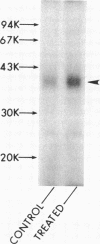Abstract
Caffeine consumption causes significant physiologic effects due to its antagonism of adenosine receptors. The A1 adenosine receptor is coupled in an inhibitory manner to adenylate cyclase. To study the effects of chronic caffeine ingestion, rats were provided with 0.1% caffeine drinking solution for 28 d. The A1 adenosine receptor agonist radioligand [3H]phenylisopropyladenosine identifies two affinity states in control rat cerebral cortex membranes with a high affinity dissociation constant (KH) of 0.40 +/- 0.08 nM and low affinity dissociation constant (KL) of 13.7 +/- 3.9 nM, with 33% of the receptors in the high affinity state. In membranes from caffeine-treated animals, all of the A1 receptors are shifted to the high affinity state with a dissociation constant (KD) of 0.59 +/- 0.06 nM. Guanylyl-imidodiphosphate (10(-4) M) decreases binding by 43% in control membrane, with no change in KH or KL, while membrane binding in caffeine-treated animals decreases by 45% with a threefold shift in KD to 1.5 +/- 0.3 nM. Concomitant with the enhanced high affinity A1 receptor state and increased sensitivity to guanine nucleotides, membranes from treated animals show a 35% enhancement in (-)-N6-(R-phenylisopropyl)adenosine-mediated inhibition of adenylate cyclase compared with controls (P less than 0.03). Photoaffinity crosslinking the receptors with [125I]N6-2-(3-iodo-4-aminophenyl)ethyladenosine reveals that A1 receptors from both groups migrate as Mr 38,000 proteins. beta-adrenergic receptor binding with [125I]iodocyanopindolol shows a decrease in the number of beta-receptors from 233 +/- 7 fmol/mg protein in control membranes to 190 +/- 10 fmol/mg protein in treated membranes (P = 0.01). These data indicate that the adenosine receptor antagonist, caffeine, induces a compensatory sensitization of the A1 receptor-adenylate cyclase system and downregulation of beta-adrenergic receptors, and provides a molecular mechanism for the caffeine withdrawal syndrome.
Full text
PDF
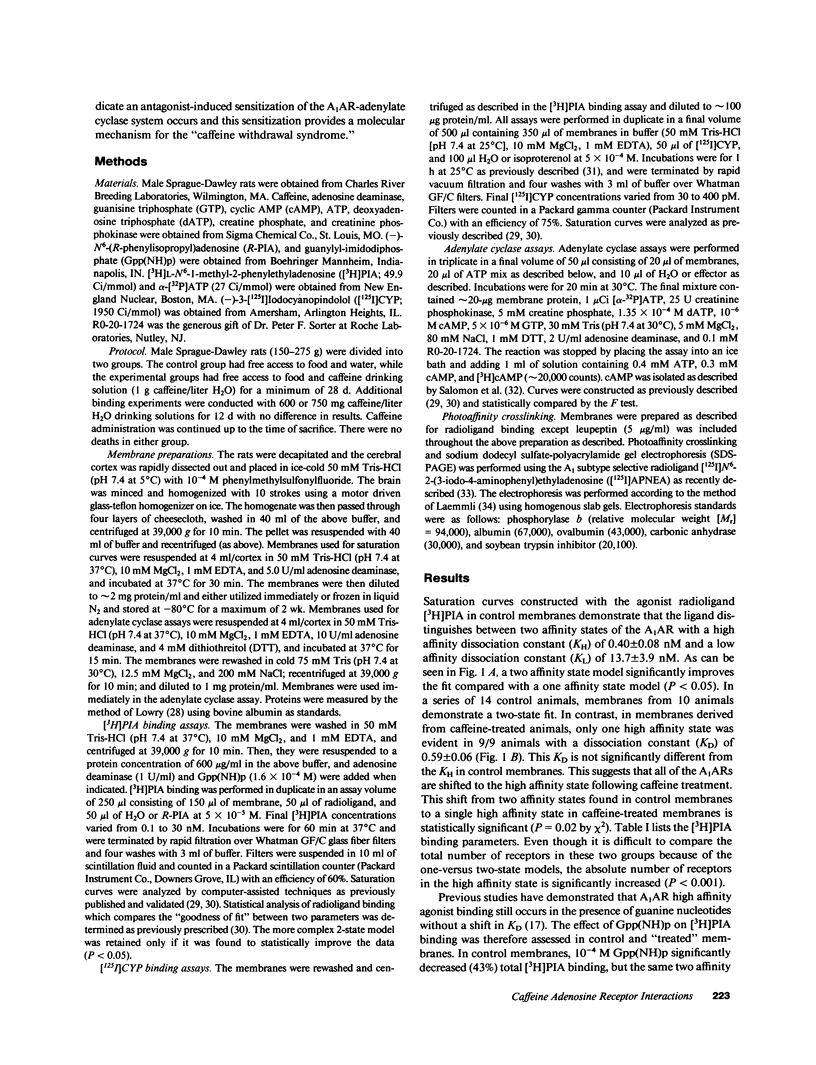
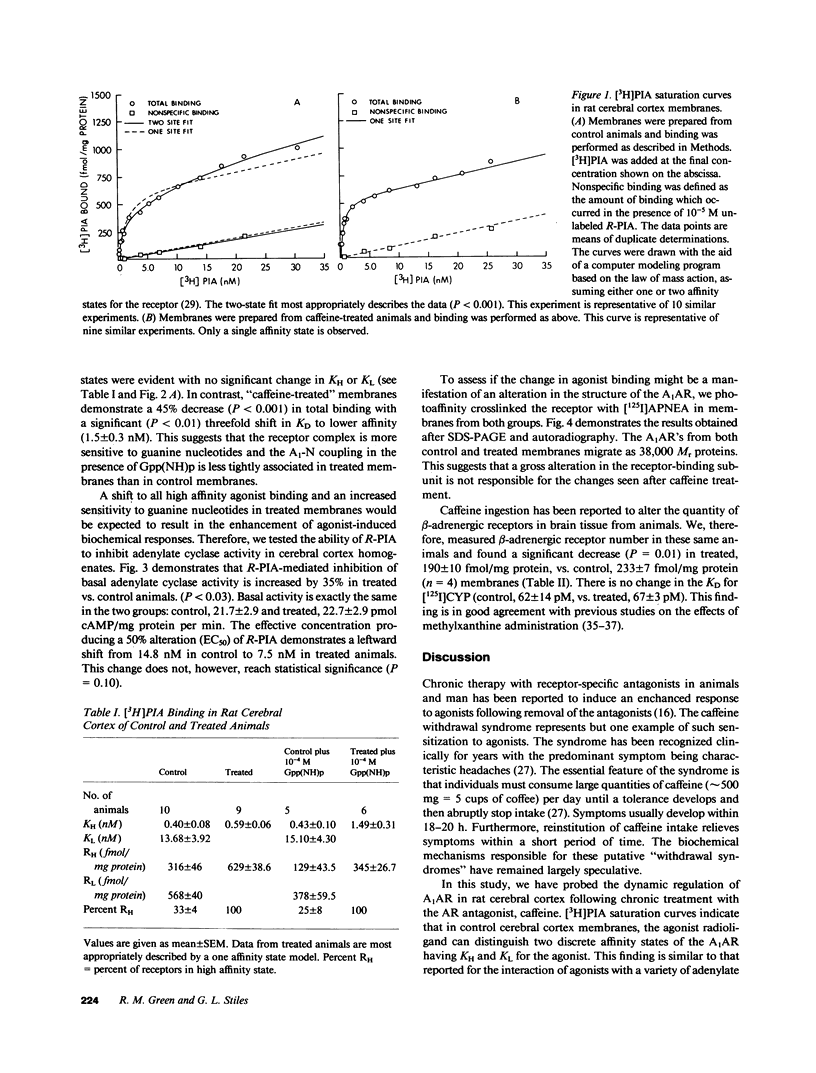

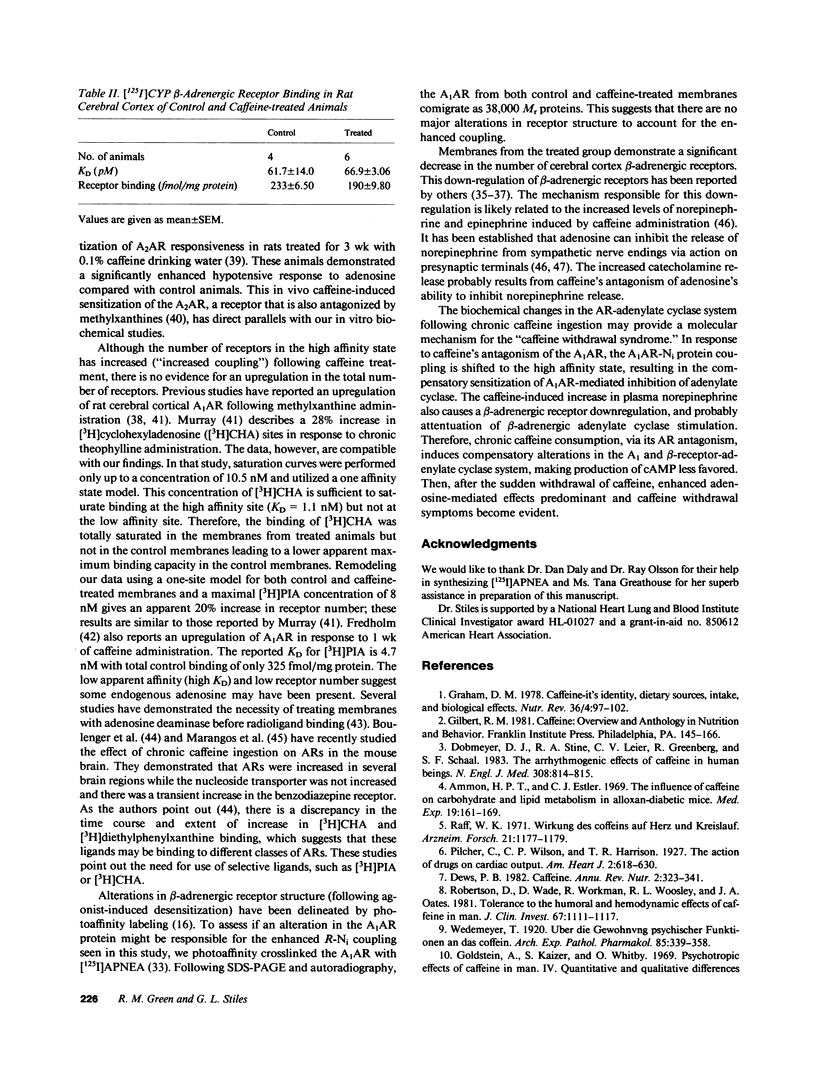
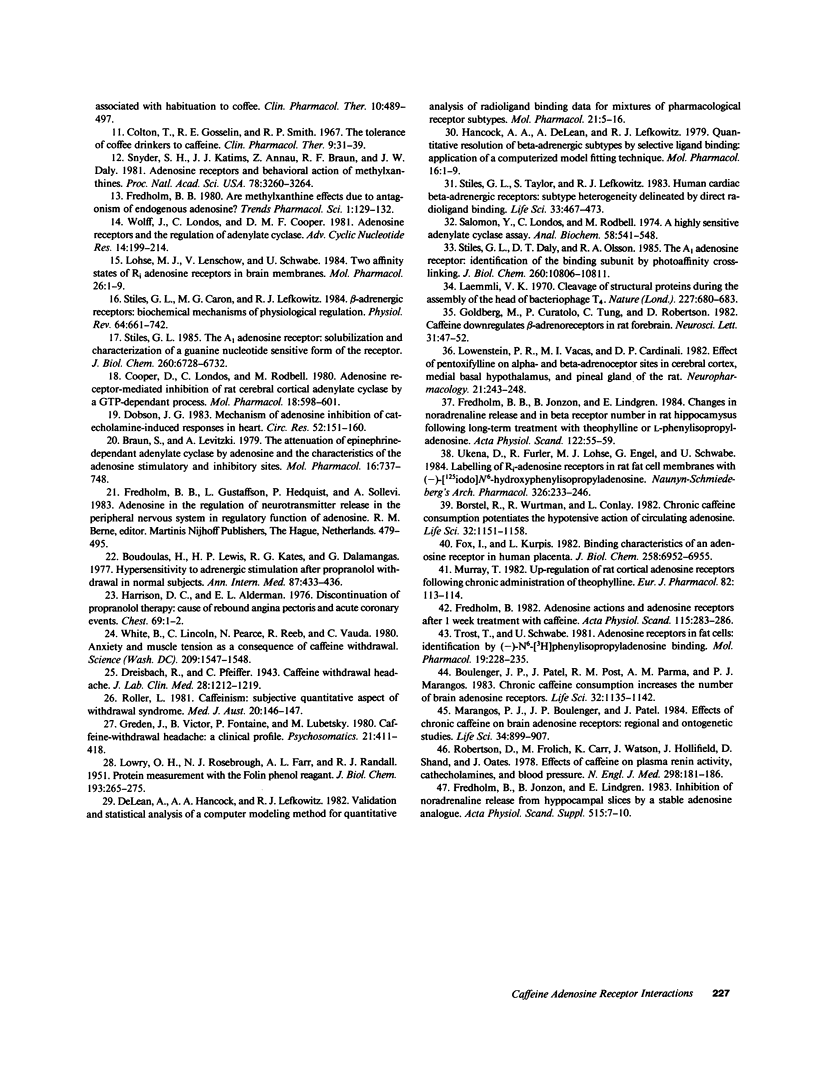
Images in this article
Selected References
These references are in PubMed. This may not be the complete list of references from this article.
- Ammon H. P., Estler C. J. The influence of caffeine on carbohydrate and lipid metabolism in alloxan-diabetic mice. Med Exp Int J Exp Med. 1969;19(3):161–169. doi: 10.1159/000137193. [DOI] [PubMed] [Google Scholar]
- Boudoulas H., Lewis R. P., Kates R. E., Dalamangas G. Hypersensitivity to adrenergic stimulation after propranolol withdrawal in normal subjects. Ann Intern Med. 1977 Oct;87(4):433–436. doi: 10.7326/0003-4819-87-4-433. [DOI] [PubMed] [Google Scholar]
- Boulenger J. P., Patel J., Post R. M., Parma A. M., Marangos P. J. Chronic caffeine consumption increases the number of brain adenosine receptors. Life Sci. 1983 Mar 7;32(10):1135–1142. doi: 10.1016/0024-3205(83)90119-4. [DOI] [PubMed] [Google Scholar]
- Braun S., Levitzki A. The attenuation of epinephrine-dependent adenylate cyclase by adenosine and the characteristics of the adenosine stimulatory and inhibitory sites. Mol Pharmacol. 1979 Nov;16(3):737–748. [PubMed] [Google Scholar]
- Colton T., Gosselin R. E., Smith R. P. The tolerance of coffee drinkers to caffeine. Clin Pharmacol Ther. 1968 Jan-Feb;9(1):31–39. doi: 10.1002/cpt19689131. [DOI] [PubMed] [Google Scholar]
- Cooper D. M., Londos C., Rodbell M. Adenosine receptor-mediated inhibition of rat cerebral cortical adenylate cyclase by a GTP-dependent process. Mol Pharmacol. 1980 Nov;18(3):598–601. [PubMed] [Google Scholar]
- De Lean A., Hancock A. A., Lefkowitz R. J. Validation and statistical analysis of a computer modeling method for quantitative analysis of radioligand binding data for mixtures of pharmacological receptor subtypes. Mol Pharmacol. 1982 Jan;21(1):5–16. [PubMed] [Google Scholar]
- Dews P. B. Caffeine. Annu Rev Nutr. 1982;2:323–341. doi: 10.1146/annurev.nu.02.070182.001543. [DOI] [PubMed] [Google Scholar]
- Dobmeyer D. J., Stine R. A., Leier C. V., Greenberg R., Schaal S. F. The arrhythmogenic effects of caffeine in human beings. N Engl J Med. 1983 Apr 7;308(14):814–816. doi: 10.1056/NEJM198304073081405. [DOI] [PubMed] [Google Scholar]
- Dobson J. G., Jr Mechanism of adenosine inhibition of catecholamine-induced responses in heart. Circ Res. 1983 Feb;52(2):151–160. doi: 10.1161/01.res.52.2.151. [DOI] [PubMed] [Google Scholar]
- Fox I. H., Kurpis L. Binding characteristics of an adenosine receptor in human placenta. J Biol Chem. 1983 Jun 10;258(11):6952–6955. [PubMed] [Google Scholar]
- Fredholm B. B. Adenosine actions and adenosine receptors after 1 week treatment with caffeine. Acta Physiol Scand. 1982 Jun;115(2):283–286. doi: 10.1111/j.1748-1716.1982.tb07078.x. [DOI] [PubMed] [Google Scholar]
- Fredholm B. B., Jonzon B., Lindgren E. Changes in noradrenaline release and in beta receptor number in rat hippocampus following long-term treatment with theophylline or L-phenylisopropyladenosine. Acta Physiol Scand. 1984 Sep;122(1):55–59. doi: 10.1111/j.1748-1716.1984.tb07481.x. [DOI] [PubMed] [Google Scholar]
- Fredholm B. B., Jonzon B., Lindgren E. Inhibition of noradrenaline release from hippocampal slices by a stable adenosine analogue. Acta Physiol Scand Suppl. 1983;515:7–10. [PubMed] [Google Scholar]
- Goldberg M. R., Curatolo P. W., Tung C. S., Robertson D. Caffeine down-regulates beta adrenoreceptors in rat forebrain. Neurosci Lett. 1982 Jul 20;31(1):47–52. doi: 10.1016/0304-3940(82)90052-0. [DOI] [PubMed] [Google Scholar]
- Goldstein A., Kaizer S., Whitby O. Psychotropic effects of caffeine in man. IV. Quantitative and qualitative differences associated with habituation to coffee. Clin Pharmacol Ther. 1969 Jul-Aug;10(4):489–497. doi: 10.1002/cpt1969104489. [DOI] [PubMed] [Google Scholar]
- Graham D. M. Caffeine--its identity, dietary sources, intake and biological effects. Nutr Rev. 1978 Apr;36(4):97–102. doi: 10.1111/j.1753-4887.1978.tb03717.x. [DOI] [PubMed] [Google Scholar]
- Greden J. F., Victor B. S., Fontaine P., Lubetsky M. Caffeine-withdrawal headache: a clinical profile. Psychosomatics. 1980 May;21(5):411-3, 417-8. doi: 10.1016/S0033-3182(80)73670-8. [DOI] [PubMed] [Google Scholar]
- Hancock A. A., DeLean A. L., Lefkowitz R. J. Quantitative resolution of beta-adrenergic receptor subtypes by selective ligand binding: application of a computerized model fitting technique. Mol Pharmacol. 1979 Jul;16(1):1–9. [PubMed] [Google Scholar]
- Harrison D. C., Alderman E. L. Editorial: Discontinuation of propranolol therapy. Cause of rebound angina pectoris and acute coronary events. Chest. 1976 Jan;69(1):1–2. doi: 10.1378/chest.69.1.1. [DOI] [PubMed] [Google Scholar]
- LOWRY O. H., ROSEBROUGH N. J., FARR A. L., RANDALL R. J. Protein measurement with the Folin phenol reagent. J Biol Chem. 1951 Nov;193(1):265–275. [PubMed] [Google Scholar]
- Laemmli U. K. Cleavage of structural proteins during the assembly of the head of bacteriophage T4. Nature. 1970 Aug 15;227(5259):680–685. doi: 10.1038/227680a0. [DOI] [PubMed] [Google Scholar]
- Lohse M. J., Lenschow V., Schwabe U. Two affinity states of Ri adenosine receptors in brain membranes. Analysis of guanine nucleotide and temperature effects on radioligand binding. Mol Pharmacol. 1984 Jul;26(1):1–9. [PubMed] [Google Scholar]
- Lowenstein P. R., Vacas M. I., Cardinali D. P. Effect of pentoxifylline on alpha- and beta-adrenoceptor sites in cerebral cortex medial basal hypothalamus and pineal gland of the rat. Neuropharmacology. 1982 Mar;21(3):243–248. doi: 10.1016/0028-3908(82)90194-0. [DOI] [PubMed] [Google Scholar]
- Marangos P. J., Boulenger J. P., Patel J. Effects of chronic caffeine on brain adenosine receptors: regional and ontogenetic studies. Life Sci. 1984 Feb 27;34(9):899–907. doi: 10.1016/0024-3205(84)90207-8. [DOI] [PubMed] [Google Scholar]
- Murray T. F. Up-regulation of rat cortical adenosine receptors following chronic administration of theophylline. Eur J Pharmacol. 1982 Aug 13;82(1-2):113–114. doi: 10.1016/0014-2999(82)90563-5. [DOI] [PubMed] [Google Scholar]
- Raff W. K., Scholtholt J., Lochner W. Wirkungen des Coffeins auf Herz und Kreislauf. Arzneimittelforschung. 1971 Aug;21(8):1177–1179. [PubMed] [Google Scholar]
- Robertson D., Frölich J. C., Carr R. K., Watson J. T., Hollifield J. W., Shand D. G., Oates J. A. Effects of caffeine on plasma renin activity, catecholamines and blood pressure. N Engl J Med. 1978 Jan 26;298(4):181–186. doi: 10.1056/NEJM197801262980403. [DOI] [PubMed] [Google Scholar]
- Robertson D., Wade D., Workman R., Woosley R. L., Oates J. A. Tolerance to the humoral and hemodynamic effects of caffeine in man. J Clin Invest. 1981 Apr;67(4):1111–1117. doi: 10.1172/JCI110124. [DOI] [PMC free article] [PubMed] [Google Scholar]
- Roller L. Caffeinism: subjective quantitative aspect of withdrawal syndrome. Med J Aust. 1981 Feb 7;1(3):146–146. doi: 10.5694/j.1326-5377.1981.tb135407.x. [DOI] [PubMed] [Google Scholar]
- Salomon Y., Londos C., Rodbell M. A highly sensitive adenylate cyclase assay. Anal Biochem. 1974 Apr;58(2):541–548. doi: 10.1016/0003-2697(74)90222-x. [DOI] [PubMed] [Google Scholar]
- Snyder S. H., Katims J. J., Annau Z., Bruns R. F., Daly J. W. Adenosine receptors and behavioral actions of methylxanthines. Proc Natl Acad Sci U S A. 1981 May;78(5):3260–3264. doi: 10.1073/pnas.78.5.3260. [DOI] [PMC free article] [PubMed] [Google Scholar]
- Stiles G. L., Caron M. G., Lefkowitz R. J. Beta-adrenergic receptors: biochemical mechanisms of physiological regulation. Physiol Rev. 1984 Apr;64(2):661–743. doi: 10.1152/physrev.1984.64.2.661. [DOI] [PubMed] [Google Scholar]
- Stiles G. L., Daly D. T., Olsson R. A. The A1 adenosine receptor. Identification of the binding subunit by photoaffinity cross-linking. J Biol Chem. 1985 Sep 5;260(19):10806–10811. [PubMed] [Google Scholar]
- Stiles G. L., Taylor S., Lefkowitz R. J. Human cardiac beta-adrenergic receptors: subtype heterogeneity delineated by direct radioligand binding. Life Sci. 1983 Aug 1;33(5):467–473. doi: 10.1016/0024-3205(83)90796-8. [DOI] [PubMed] [Google Scholar]
- Stiles G. L. The A1 adenosine receptor. Solubilization and characterization of a guanine nucleotide-sensitive form of the receptor. J Biol Chem. 1985 Jun 10;260(11):6728–6732. [PubMed] [Google Scholar]
- Trost T., Schwabe U. Adenosine receptors in fat cells. Identification by (-)-N6-[3H]phenylisopropyladenosine binding. Mol Pharmacol. 1981 Mar;19(2):228–235. [PubMed] [Google Scholar]
- Ukena D., Furler R., Lohse M. J., Engel G., Schwabe U. Labelling of Ri adenosine receptors in rat fat cell membranes with (-)-[125iodo]N6-hydroxyphenylisopropyladenosine. Naunyn Schmiedebergs Arch Pharmacol. 1984 Jun;326(3):233–240. doi: 10.1007/BF00505324. [DOI] [PubMed] [Google Scholar]
- White B. C., Lincoln C. A., Pearce N. W., Reeb R., Vaida C. Anxiety and muscle tension as consequences of caffeine withdrawal. Science. 1980 Sep 26;209(4464):1547–1548. doi: 10.1126/science.7433978. [DOI] [PubMed] [Google Scholar]
- Wolff J., Londos C., Cooper D. M. Adenosine receptors and the regulation of adenylate cyclase. Adv Cyclic Nucleotide Res. 1981;14:199–214. [PubMed] [Google Scholar]
- von Borstel R. W., Wurtman R. J., Conlay L. A. Chronic caffeine consumption potentiates the hypotensive action of circulating adenosine. Life Sci. 1983 Mar 7;32(10):1151–1158. doi: 10.1016/0024-3205(83)90121-2. [DOI] [PubMed] [Google Scholar]



